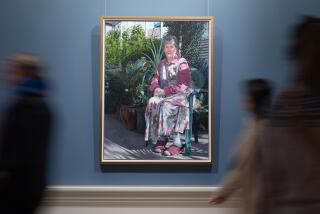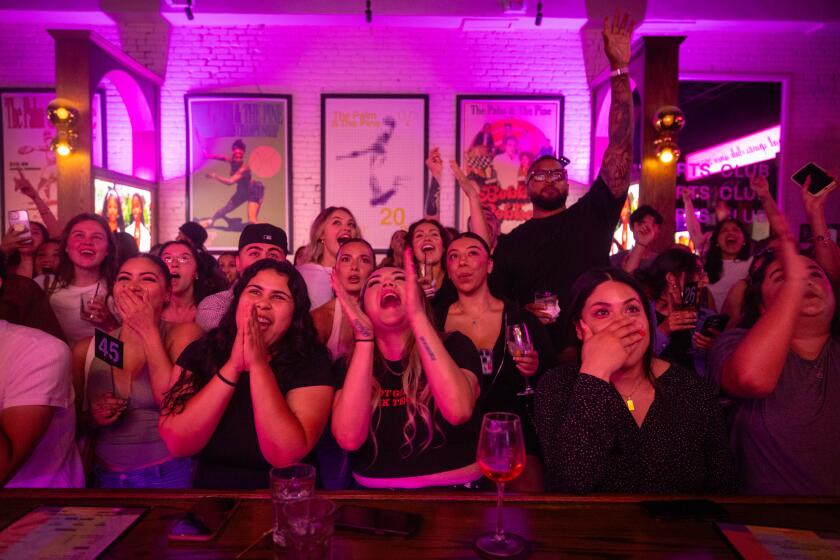Breezy Riders
- Share via
KILLARNEY, Ireland — We were faced with a problem as we left the after-hours pub in the small town of Killorglin. It was 3:30 a.m., and my cycling companion and I were (as the Irish say) falling-down drunk. When it was our turn to lead the bar patrons in song, we responded with the Beach Boys’ “Barbara Ann” and “Red River Valley” with a bit of Gregorian chant in between. Our audacity was applauded. Drinks were bought. Now, the problem: how to walk from the bar to our B&B; two miles away down pitch-black country roads. “Thank God I have a disposable camera with a flash,” my friend John shouted to no one in particular.
With the flash, we expected we could illuminate the road about 50 yards at a time. So, with an arm around my shoulder, John held the camera out in front of us. Perhaps it shouldn’t have been a surprise, but in that coal-black darkness, and given our addled state, the flash blinded us. We scrambled on our knees on the asphalt, howling in pain. When we could see again, we had no idea which way we were facing, and I have no idea how we got home. But in a few hours’ time, we were back with our tour group, completing a weeklong bike trip along the Ring of Kerry and the Dingle Peninsula in southwest Ireland.
*
I’d found Irish Cycling Safaris on the Internet. The Dublin-based company charged one-third the price of its U.S. counterparts, whose glossy catalogs featured handsome couples in cashmere sweaters sipping wine near crackling fires.
My riding companions turned out to be a motley crew, with not a cashmere sweater in sight. Two Norwegian couples, middle-age and gregarious. Two German couples of similar description. A Vermont legislator and her 16-year-old son and his friend. An American couple in their 20s and a similarly aged Belgian couple. Two women from upstate New York who identified themselves as roommates. A lawyer from Boston now working in Israel. A chain-smoking Dane in her 60s. A commercial artist from Britain. My drinking companion, John, an Irish business consultant living in England. My longtime friend, Aisling, an Irish citizen living in Costa Rica. And “meself,” a fourth-generation (mostly) Irish American visiting the home country for the first time.
I have done a dozen commercial bike tours in the U.S., and the first thing to be said about this Irish adventure is that it was not like those. Cycling tours offered by Americans often have a seriousness about them. To bed at 9:30. Granola in the morning. Top-of-the-line gear and clothing. A certain machismo. Cycling as fitness. The Irish tour was altogether different.
That difference became apparent when we chose our bikes the first morning in Killarney. (The package ran from Saturday evening to Saturday morning.) While an American outfit might be expected to offer mid-range name-brand bikes in top condition, we were offered the kind you might expect to rent in a public park. Still, the 15-speed Raleigh hybrids were serviceable. A long day on this tour might mean 30 miles, about half the distance a Spandex-clad customer might expect on a comparable U.S. tour. Given our group’s average speed of about 12 mph, the short distances meant late breakfasts, long lunches and breaks when we felt like it.
In fact, we had not been on the road for even an hour that Sunday morning when the group took its first break for tea and cakes. The Europeans lit cigarettes, shamelessly, as Europeans are wont to do. The Dane pulled out her pint of schnapps.
While Irish Cycling Safaris provided helmets to those who wanted them, most of my companions considered such headgear optional. It soon became clear that fitness, too, was optional. And except for padded cycling shorts, few made any concessions in their usual wardrobe. We were, in short, not serious cyclists but a band of merrymakers on holiday, and our rental bikes were merely a means to that end.
It didn’t seem like fun an hour or two later as we cycled uphill in a downpour on a road with no shoulder while tour buses queued behind us. Along with a waterproof jacket, it makes sense to take the Irish point of view that rain is not a cause for distress but simply another kind of weather. Overall, however, we were blessed last August with an unusual number of sunny hours.
In compensation for precipitation, Ireland offered us spectacular landscapes and vistas and food. After several hours of our first sodden uphill slog, we found ourselves in sunshine and the almost alpine beauty of Moll’s Gap. It was time for lunch, and I expected the little store there to offer something like what might be found in similar circumstances in the U.S.--say, hot chocolate and plastic-wrapped sandwiches. Instead, the fare included salads, smoked salmon and freshly baked bread.
That Sunday night we stayed in Sneem, scattered in various B&Bs; around the village. The price of our weeklong tour included accommodations, a bicycle, a guide and a van to transport our luggage. Sometimes the accommodations were like that of a hotel, but more typically they resembled a room in your aunt’s home--if every morning your aunt offered the “full Irish breakfast” of ham, sausage, eggs, toast, fried tomatoes and mushrooms, cereal, oatmeal, juice and more.
*
On Monday, we wheeled along narrow country roads past Licken Woods and Lough Caragh on our way to a stopover in Glenbeigh. There, our guide, Paddy, proposed something special: In his hometown not far away, this was the last night of the Puck Fair. We all made a modest contribution to rent a bus to take us there. And so, after dinner, we found ourselves in streets thronged with revelers.
In retrospect, the late hours we kept in celebration of Puck the He-Goat might not have been a good idea. The coming day we were to make our assault on Connor Pass, the highest roadway point in Ireland.
In the morning, a bus took us and our equipment to Camp, a town on the Dingle Peninsula. Knowing what lay ahead, half of the group piled into the van with Paddy, opting to cross Connor Pass in comfort. Others delayed the challenge by stopping first at a pub in Stradbally. But John, Aisling and I packed our handlebar bags with sandwiches, juices and candy bars, figuring to get halfway up the pass and then have a very long lunch.
John said that in Gaelic certain kinds of roads are described as “crock-a-gee” (as he pronounced it), winding vertically as well as horizontally. Connor Pass was such a road. So, halfway up and with sore bums, we stopped for our two-hour lunch break and the spectacular views. In another torturous hour or so, we made it to the top and congratulated ourselves.
From there, it was a long and wonderful downhill into the seaside town of Dingle. Congratulations still seemed in order, so we traveled on to thick coffee and sweet cakes and a fit of book-buying at An Cafe Liteartha. The congratulations continued on to An Droichead Beag, a pub where that night I would hear the best session of traditional and contemporary Irish music I had ever heard.
As if anticipating such wild cultural explorations and such late hours spent in the company of Lord Guinness, the touring firm had designed the fifth day as a day of rest in Dingle. I and my chums took the ferry for a ramble on Great Blasket Island. But by 10 that night we were all assembled outside Flaherty’s pub, engaged in contests of wit and banter with local folks, bright-eyed and oblivious to the rain.
*
After our day off, Thursday was smooth sailing. A mid-morning coffee break, a lunchtime swim at Inch and an afternoon of level roads eventually brought us to Killorglin, Paddy’s hometown.
The pope should canonize Patrick Maher, our guide. I have never encountered a person in his position who was so unfailingly patient and helpful and downright funny and kind. From 6 a.m. until midnight, he hauled luggage from hotel room to hotel room, repaired bikes, encouraged the crestfallen, transported the discouraged, looked for the lost, found ATMs, advised us about the best bars and at midnight helped folks through bedroom windows when they had forgotten their door keys. One might imagine, consequently, that he was taking a great risk when he arranged to have the tour stop a night in his hometown, where he offered to introduce us to his regular pub and to his neighbors.
I confess to still being wobbly when I mounted my bike to begin our last day. First was an uphill slog to the Gap of Dunloe. Down the other side, our attention was caught by a sign that read “Freshly Cut Sandwiches.” As John and Aisling and I ate, someone noticed a handwritten sign: “Shortcut to Killarney. Boat ferry. Will transport bikes.”
This presented us with a dilemma. We could continue on the route marked out for us by the tour company, do a great deal of climbing over another summit and have bragging rights among those who feel fitness is important. Or we could take the easy way, have a bit of adventure and do the unexpected, if the true purpose of this cycling trip was not fitness but fun.
(BEGIN TEXT OF INFOBOX / INFOGRAPHIC)
GUIDEBOOK
Pedal Players in Ireland
Getting there: Only Delta offers connecting service LAX-Shannon; fares begin at $946 round trip. Lower fares are available with change of carriers on Continental, American, United and Aer Lingus.
Bike tours: Irish Cycling Safaris, 7 Dartry Park, Dublin 6, Ireland; telephone 011-353-1-260-0749, fax 011-353-1-706-1168, Internet https://www.kerna.ie/ics/. It offers weeklong tours at about $440, including accommodations, guide and bike rental.
Often-cited U.S.-based guided tour companies: Backroads, tel. (800) 462-2848, which offers eight-day Ireland cycling tours with deluxe accommodations for $2,940; and Brendan Tours, tel. (800) 421-8446, which has eight-day cycling tours for $1,558.
For more information: Irish Tourist Board, 345 Park Ave., 17th floor, New York, NY 10154; tel. (800) 223-6470, fax (800) 748-3739.
More to Read
Sign up for The Wild
We’ll help you find the best places to hike, bike and run, as well as the perfect silent spots for meditation and yoga.
You may occasionally receive promotional content from the Los Angeles Times.






